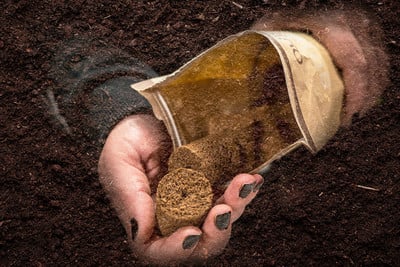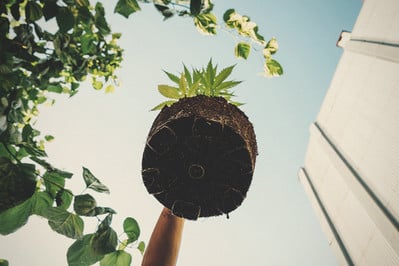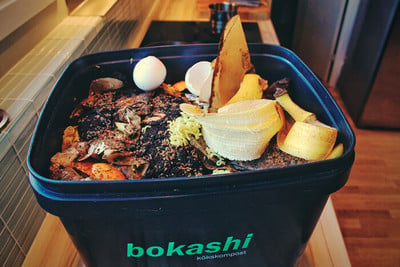.

All About Cannabis Roots — History, Uses, and Benefits
Although research on the topic remains limited, studies and anecdotal evidence indicate there are many uses for cannabis roots. What are the potential benefits of this often overlooked part of the plant?
Contents:
It’s no secret that cannabis has numerous applications. Thanks to the endocannabinoid system that exists in the bodies of all living creatures (except insects), compounds within the cannabis plant interact with receptors in our bodies, producing all the effects this plant has become famous for.
From promoting an improved mood to easing tension and soothing the body, there are an untold number of benefits just waiting to be explored. This is why cannabis has long been used for holistic purposes, and why researchers today are continuing to probe the herb for its potential clinical applications.
Most of the time, when people talk about using cannabis, they’re referring to smoking the flowers or ingesting the oils extracted from the plant. One part of the anatomy that may seem rather neglected, perhaps because they are out of sight most of the time, are the roots.
However, cannabis roots should not be overlooked, as they have some incredibly vital functions spanning from the industrial to the holistic. So, what exactly can be done with cannabis roots? Let’s find out.
The History of Cannabis Root Use
It is not very common to hear of people using cannabis roots for any reason these days. Typically, they’re discarded as waste products during harvest. Historically, however, they’ve been used therapeutically for thousands of years. Chinese texts dating back to 2700 BCE describe using cannabis roots to ease physical discomfort during surgery and to take the edge off bone breaks and fractures.
The texts describe how the roots were prepared—dried, then ground up to form a thick paste that was applied topically. They were also juiced or boiled to make a tea that was used to stop bleeding during childbirth, soothe the body, and to promote healthy urine production. There’s even one report of dried, powdered root being used to “pull out” and neutralise the venom from a scorpion sting.
And they weren’t the only ancient culture to utilise cannabis roots for therapeutic purposes. Roman historian Pliny the Elder is said to have written detailed accounts of holistic cannabis use sometime around 79 BCE, detailing how it can be used to soothe burns, care for joints, and ease gout. Many are doubtful of the authenticity of Pliny’s accounts, but regardless, they are worth taking into consideration.
Moving even closer to our time period, in the 18th century, English physician William Salmon wrote about how cannabis roots can be used to promote supple joints and ease sciatica symptoms. Despite some differences in applications, the common link between all these ancient texts seems to be soothing the body.
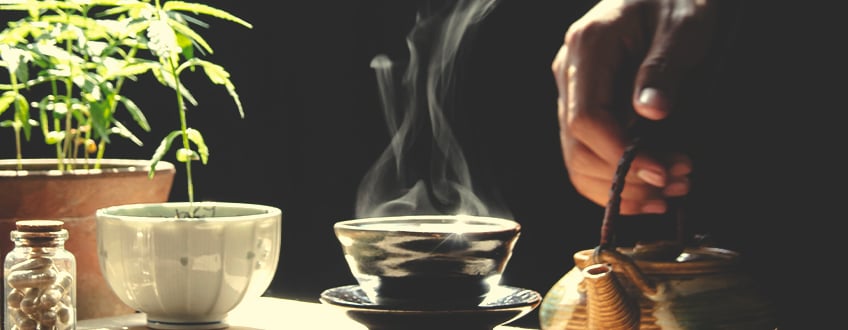
Modern Uses of Cannabis Roots
Although the above accounts paint a rich picture of the history of cannabis roots, it’s important to take into consideration their limitations as well. While they may be helpful for some, they shouldn’t be considered a standalone treatment.
Cannabis roots are much less popular than the flowers, but they’re finding their place in the modern market as well. Cannabis root extract is now an ingredient in many topical products, such as salves, lotions, balms, massage oils, and more.
It’s not often used in ingestible products, but it can be brewed into a tea by slowly simmering the dried and powdered root in a crock pot. You can add cinnamon bark, anise, or other aromatics for flavor, then simply strain and enjoy.
Do Cannabis Roots Contain Cannabinoids or Terpenes?
There is evidence suggesting that cannabis roots do contain trace amounts of cannabinoids, mostly CBD (cannabidiol), although it’s likely not enough to impart a discernible effect. That said, the concentration of cannabinoids in cannabis roots depends on many factors, such as the strain, and where and how it was cultivated.
A Canadian study[1] published in 2012 analyzed Finola hemp and found that the flowers contained CBDA, which is the acidic precursor to CBD found in basically all parts of the raw cannabis plant, including the flowers. Before heat is applied (a process known as decarboxylation), raw cannabis plants contain cannabinoid acids, not the cannabinoids (CBD, THC, etc.) themselves.
Studies regarding high-THC strains have yet to be conducted, but considering the evidence we do have, it’s safe to assume there will be much lower concentrations of THC/THCA in the roots than in the flowers and leaves.
Like cannabinoids, terpenes are essential to the benefits offered by the cannabis plant. Interestingly, a couple of terpenes have been identified in cannabis roots that don’t exist in notable concentrations in other parts of the plant.
Back in 1971, researchers found[2] cannabis root to contain both friedelin and epifriedelanol, two triterpenoids used to defend against plant predators that may be able to benefit human health and wellness as well.
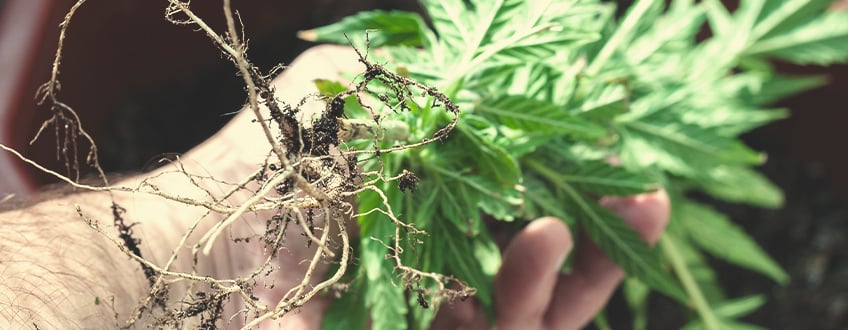
Benefits of Cannabis Roots: What the Research Says
Cannabis roots have yet to find their way into Western medications, as the body of study on their effects is still very limited. But, the small amount of research we do have is very encouraging; perhaps cannabis roots do have a place in modern medicine and wellness.
A 2017 article[3] published in the journal Cannabis and Cannabinoid Research concluded:
“The current available data on the pharmacology of cannabis root components provide significant support to the historical and ethnobotanical claims of clinical efficacy. Certainly, this suggests the need for reexamination of whole root preparations on inflammatory and malignant conditions employing modern scientific techniques”.
Throughout the article, the authors highlight a few different methods in which cannabis roots could potentially be therapeutic. For example, they cite friedelin—a triterpenoid mentioned above—for its potential liver-protective properties. Another type of cannabis root compound, called pentacyclic triterpene ketones, are known to have antimicrobial and anti-inflammatory effects.
Cannabis roots also contain small amounts of choline, a powerful macronutrient that plays a role in many important biological processes, such as nerve function, brain development, and energy levels/reserves.
How to Harvest, Clean, and Store Cannabis Roots
If you’re looking to make your own cannabis root brew or topical, you first need to acquire your roots.
- To harvest your roots from the soil, begin by making sure the substrate is moist enough to ensure easy removal. The more packed and dry it is, the more difficult the process will be.
- Next, take a small shovel or spade and dig deep enough under the root ball so you’re not chopping the roots up as you remove them.
- Once you’ve harvested your roots, it’s time to separate them from the main stem using a clean, sharp knife or scissors.
- Now, rinse the roots very well until no dirt remains.
- From here, store your clean roots in a dry, dark area for two days.
You can store your dry roots in airtight Mason jars like you would cannabis buds, but most choose to first render their roots into a balm or paste before storage.

Easy Recipes for Cannabis Roots
Now, let's get into a couple simple recipes for making a topical cannabis root balm and a root tea.
Cannabis Root Balm
- To make a cannabis root balm, grind your clean and dry roots (about 2 root balls worth) into a powder.
- Choose a type of fat, such as coconut oil, to act as a base. Mix the ground roots into the coconut oil.
- Add water (to avoid burning) and simmer over low heat for 12 hours. We recommend a 2:1 ratio of coconut oil to water.
- Allow to cool and solidify. Store in an airtight container.
Now you can use your topical cannabis root product to soothe the skin! This recipe can be tweaked to include many other types of fatty bases and additional ingredients. The only limit is your imagination!
Cannabis Root Tea
Making cannabis root tea is just as easy! Just grind the roots, add to water with other ingredients such as cinnamon, mint, anise, etc., and simmer on low heat for 12 hours. At the end, make sure to strain your concoction before drinking.
A Warning on Ingesting Cannabis Roots
Although cannabis roots do seem to offer some possible health benefits, they are very high in alkaloids that can be toxic when consumed in excess; namely, pyrrolidine and piperidine. Always consult your doctor or another trusted physician before adding anything to your daily regimen, and avoid long-term ingestion of cannabis roots.
- The hexanoyl‐CoA precursor for cannabinoid biosynthesis is formed by an acyl‐activating enzyme in Cannabis sativa trichomes https://onlinelibrary.wiley.com
- Chemical constituents of Cannabis sativa L. root - PubMed https://pubmed.ncbi.nlm.nih.gov
- Cannabis Roots: A Traditional Therapy with Future Potential for Treating Inflammation and Pain https://www.ncbi.nlm.nih.gov




























